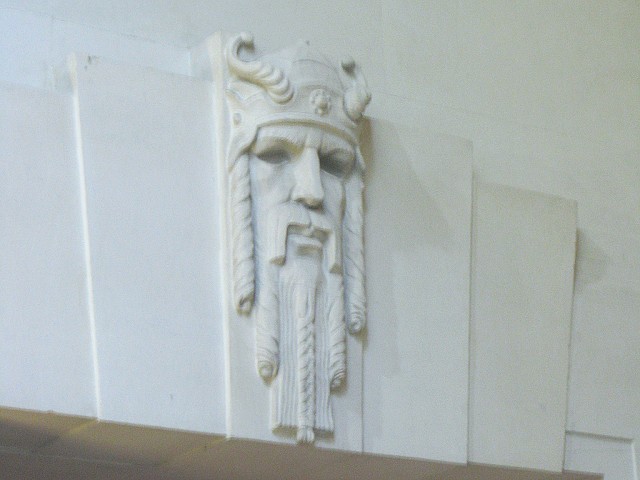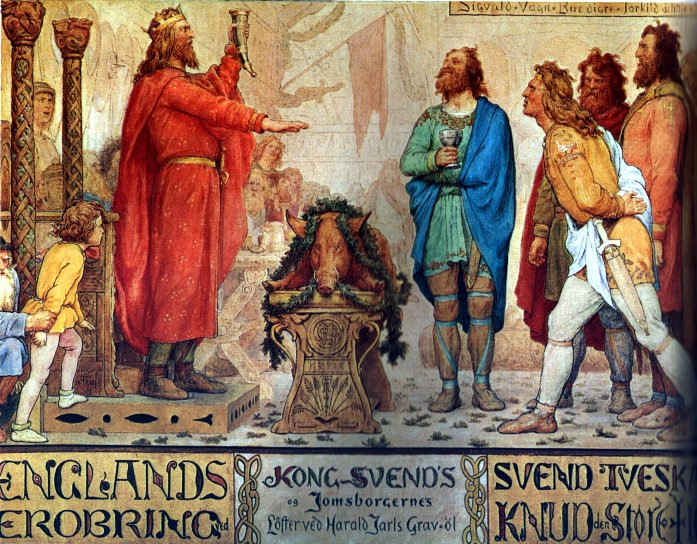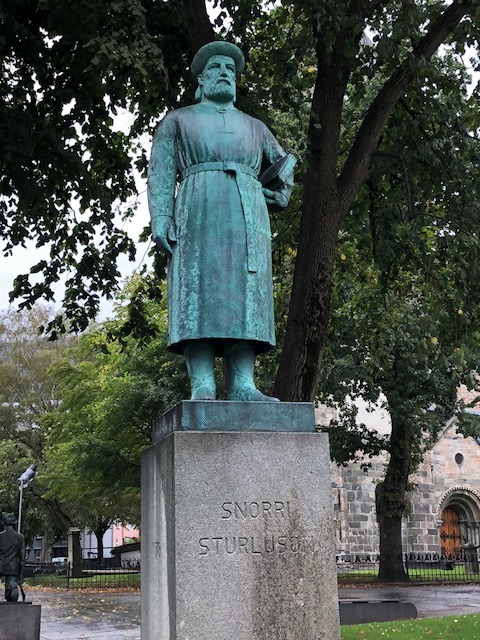
Candlemas, February 2
On this day in 1014 Swein Forkbeard died; although it might actually have been in the early hours of Feb. 3. The Anglo-Saxon Chronicle, written a decade after Swein’s death reported, confusingly:
Swein ended his days on Candlemas, February 3rd.
Only, Candlemas is on Feb. 2. You’d think that the scribes (monks) who wrote and copied the Chronicle would have known the date of Candlemas. Yet the Chronicle insists that he died on Candlemas, on Feb. 3. Odd, that. Scribal error that just kept getting re-copied? Impossible to know.
What else do we know (or not know) about the death of England’s viking king?

Photo: Nigel Davies / Viking detail in Swansea Guildhall. Wikimedia Commons
The Encomium Emmae Reginae, written about 30 years after Swein died (with input from Queen Emma), went into more detail in describing his death, even though neither Emma nor the encomiast was there to witness it:
“Feeling, therefore, that the dissolution of his body was threatening him, he summoned his son Knutr and said that he must enter upon the way of all flesh. He exhorted him much concerning the government of the kingdom and the zealous practice of Christianity, and committed the royal scepter to him. Soon afterwards he paid the last dues to nature, returning his soul to the heavens, and giving back his body to the earth.”
William of Malmesbury, writing in the 12th century added some color:
“The invader soon met his end, by what form of death is disputed. It is said that while he was ravaging the lands of St. Edmund, the martyr himself appeared to him in a vision and complained mildly about the miseries of his community; and when he (Swein) returned an insolent reply, the saint struck him on the head a blow from the pain of which he shortly afterwards died.”

Here is Swein, on the left, celebrating the death of his father, Harald Bluetooth, and Swein’s accession to the throne of Denmark.. The child on the far left, in yellow, is Swein’s younger son, Cnut, future king of England, Denmark and; Norway.
John of Worcester, also writing in the 12th century, added even more details, and he clearly had a dim opinion of Swein:
“After many cruel atrocities, which he perpetrated both in England and in other lands, the tyrant Swein filled up the measure of his damnation by daring to demand enormous tribute from the town where the incorrupt body of the precious martyr Edmund lay. At last, at the general assembly which he held at Gainsborough, he alone saw St. Edmund, armed, coming towards him. When he had seen him, he was terrified and began to shout very noisily, saying: ‘Help, fellow-warriors, help! St. Edmund is coming to kill me!’ And while he was saying this he was run through fiercely by the saint with a spear, and he fell from the stallion on which he sat, and, tormented with great pain until twilight, he ended his life with a wretched death on 3 February.”
Snorri Sturluson, 12th c Icelandic poet wrote quite unimaginatively that King Svein suddenly died at night in his bed.

I ran into Snorri Sturluson in Bergen, Norway last fall.
Symeon of Durham writing in the early 12th century reported that Swein was buried at York, and this may be some indication that Swein had journeyed there from his camp at Gainsborough, and that he died at York, some fifty miles from Gainsborough. Because Symeon was a Northumbrian, he may have had knowledge of local hearsay that other chroniclers did not have. It seems quite plausible that the assembly Swein was attending, mentioned by John of Worcester, was at York, not Gainsborough. Swein would have gone there to be recognized and crowned at a gathering of the witan under the guidance of Wulfstan, Archbishop of York. (The previous king, Æthelred, had already taken shelter with his in-laws in Normandy).
Finally, a 13th century artist depicts Swein’s last moments this way:

St. Edmund puts an end to the ambitions of Swein Forkbeard.
Swein was the first Danish king of England. He would not be the last.